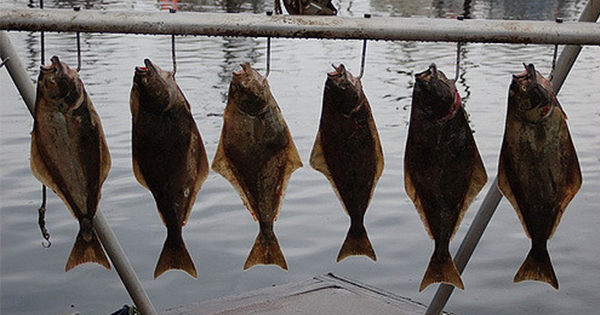
I wasn’t doing most of the fishing when we went out last Saturday. Instead, we let our friends use the three rods we keep on our 22-foot wooden skiff. Eight of us were on board, and hanging out on the bow of the boat with the sun shining on my face was fine for me. But when we were one fish shy of our legal limit, and the rest of the crew had grown weary of fishing and were starting to talk about heading back to the harbor, I baited an available rod and dropped it over. Within a few minutes of the five-pound weight hitting the muck at the bottom of the bay, I got some nibbles. Then nothing. Then they came back with force. Fish on.
With the full moon two days earlier, the tide had been so low that morning, we’d had to punt with a boat hook out of our slip and along the harbor edge into deeper water. The days of extreme tides are supposed to be mediocre for halibut fishing—the vast amount of moving water apparently drags hooks along the ocean bottom, rather than giving them a chance to linger in place and do their job. This is why the tide book shows small flatfish icons on these days and larger images next to the days with milder tides. But still, it was halibut that we were after; the bottom fish’s mild, white flesh makes for easy dinners.
Outside the harbor mouth, Kachemak Bay was glorious and calm, and we motored toward its head, into about 200 feet of water. Huge rafts of otters checked us out as we zoomed past, and we scanned the flat water for signs of humpback whales, which have been active in the bay all summer.
About half an hour in, our friend’s 13-year-old daughter hooked into something large. Hoots and hollers went up as she reeled in what looked like a 30 or 40-pounder. Its head and tail stuck out of the fish tote in the stern of our boat.
Halibut are not beautiful fish, but if you stare at them long enough, you can appreciate something lovely—or at least impressive—about their countershading. Their bellies are stark white and their backs mottled brown to blend in with the seafloor, with not a single error in their coloration.
All summer long, thousands of tourists come to Homer to fish for halibut. A wooden sign at the crest of the hill overlooking Homer and Kachemak Bay proclaims our hometown the “Halibut Fishing Capital of the World.” And it might well be. Anglers from across the country and world head out on charter boats day after day, catching their two fish per day limit, many shipping hundreds of pounds of fish back home. If you walk around the harbor area in the afternoon, you see strings of halibut—as well as salmon, rockfish, and cod—on display, so paying customers can get photos of their haul. The sheer amount of biomass that comes out of our bay is mind-boggling.
Earlier that week, we’d gone fishing with the same family. That time their 15-year-old son hooked into something huge. It took him ages to bring it up, and we waited eagerly to see—would it be a 100-pound halibut? Larger? But as it got close to the surface, we saw a square flash of white and tan: an enormous skate. My husband pulled the massive ray up to the side of the boat, where its yellow, slit eyes glared at us. On its underside, a wide mouth in the shape of a grin had fat, sandpapery lips and looked strangely human. Although there is some interest in starting commercial fisheries in Alaska for skate, we released the ray, and it sped away. It is always amazing to be able to witness life from the bottom of the sea.
Now the tip of my fishing rod bent toward the water as I reeled in. Then the fish grabbed the line and ran off with it for a while—undoing all of the work I’d just done. I broke a sweat in my effort and had to take off my life vest to cool down. Finally I got the fish to the surface, where my husband gaffed it and hauled it into the boat.
We estimated it to be about 50 pounds, the largest fish I’ve ever caught. We were done. I bled the fish by cutting its gills. We put the rods away and returned to the harbor.
In all, we caught well over 100 pounds of fish that day—yanking life from the bottom of the bay out into the open air. Later, when we were cutting the filets into meal-sized portions and vacuum-sealing the meat at home, I felt both giddy and unworthy. We weren’t even sure whether all of the packages would fit in our already well-stocked full-sized freezer. It was nearly an embarrassment of riches. But we plan to go back out this weekend.

